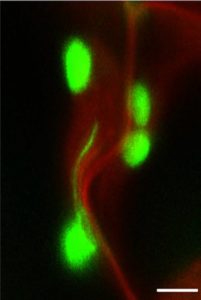Update. Stromules: Probing formation and function
ABSTRACT
 Stromules are narrow tubular structures, comprised of stroma surrounded by the envelope membrane, which emanate from all types of plastids found in vascular plants. The mechanism for formation of stromules is not understood, but investigating how they arise will be stimulated by the recent observation that they can form in vitro from chloroplasts isolated in particular conditions or in the presence of cellular protein extracts. Stromules allow the plastid compartment, with all its biosynthetic and metabolic capacity, to be placed near other subcellular locations in the cells, sometimes at considerable distance from the main plastid body. Proteins, and undoubtedly other molecules, but not DNA or ribosomes, flow through stromules, which have been implicated in retrograde signaling of pathogen invasion or light stress from chloroplast to nucleus. Stromules increase in frequency following exposures of cells to reactive oxygen species, sugar, hormones, and pathogen effector proteins, in chloroplast division mutants, and in transformed cells that overexpress plastid outer envelope proteins. Through breakage or tip shedding, stromules may also be a source of plastid-derived vesicles that can recycle plastid content during nutrient stress, but that also may have unknown roles in removal of toxic molecules or in intra- or inter-cellular communication.
Stromules are narrow tubular structures, comprised of stroma surrounded by the envelope membrane, which emanate from all types of plastids found in vascular plants. The mechanism for formation of stromules is not understood, but investigating how they arise will be stimulated by the recent observation that they can form in vitro from chloroplasts isolated in particular conditions or in the presence of cellular protein extracts. Stromules allow the plastid compartment, with all its biosynthetic and metabolic capacity, to be placed near other subcellular locations in the cells, sometimes at considerable distance from the main plastid body. Proteins, and undoubtedly other molecules, but not DNA or ribosomes, flow through stromules, which have been implicated in retrograde signaling of pathogen invasion or light stress from chloroplast to nucleus. Stromules increase in frequency following exposures of cells to reactive oxygen species, sugar, hormones, and pathogen effector proteins, in chloroplast division mutants, and in transformed cells that overexpress plastid outer envelope proteins. Through breakage or tip shedding, stromules may also be a source of plastid-derived vesicles that can recycle plastid content during nutrient stress, but that also may have unknown roles in removal of toxic molecules or in intra- or inter-cellular communication.



